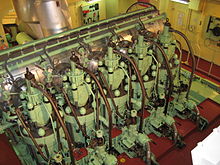 |
| The MAN B&W 5S50MC 5-cylinder, 2-stroke, low-speed marine diesel engine. This particular engine is found aboard a 29,000 tonne chemical carrier. |
Also known as slow-speed, or traditionally oil engines, the largest diesel engines are primarily used to power ships, although there are a few land-based power generation units as well. These extremely large two-stroke engines have power outputs up to approximately 85 MW (114,000 hp), operate in the range from approximately 60 to 200 rpm and are up to 15 m (50 ft) tall, and can weigh over 2,000 short tons (1,800 t). They typically use direct injection running on cheap low-grade heavy fuel, also known as Bunker C fuel, which requires heating in the ship for tanking and before injection due to the fuel's high viscosity. Often, the waste heat recovery steam boilers attached to the engine exhaust ducting generate the needed to heat required for fuel heating. Provided the heavy fuel system is kept warm and circulating, engines can be started and stopped on heavy fuel.
Large and medium marine engines are started with compressed air directly applied to the pistons. Air is applied to cylinders to start the engine forwards or backwards because they are normally directly connected to the propeller without clutch or gearbox, and to provide reverse propulsion either the engine must be run backwards or the ship will utilise an adjustable propeller. At least three cylinders are required with two-stroke engines and at least six cylinders with four-stroke engines to provide torque every 120 degrees.
Companies such as MAN B&W Diesel, (formerly Burmeister & Wain) and Wärtsilä (which acquired Sulzer Diesel) design such large low-speed engines. They are unusually narrow and tall due to the addition of a crosshead bearing. As of 2007, the 14-cylinder Wärtsilä-Sulzer 14RTFLEX96-C turbocharged two-stroke diesel engine built by Wärtsilä licensee Doosan in Korea is the most powerful diesel engine put into service, with a cylinder bore of 960 mm (37.8 in) delivering 114,800 hp (85.6 MW). It was put into service in September 2006, aboard the world's largest container ship Emma Maersk which belongs to the A.P. Moller-Maersk Group. Typical bore size for low-speed engines ranges from approximately 35 to 98 cm (14 to 39 in). As of 2008, all produced low-speed engines with crosshead bearings are in-line configurations; no Vee versions have been produced.
No comments:
Post a Comment